The 980 km of the Silver Route by bike will allow you to cross Spain from south to north passing through 4 different autonomous communities. A journey of contrasts in which you will marvel at the beautiful changes of scenery. You will cycle through the typical Andalusian and Extremaduran pastures, through olive groves, fruit trees, cereal fields and Castilian meadows. Once in Galicia, you will cross the Galician mountains discovering forests of Atlantic vegetation of great value until you reach the goal, Santiago de Compostela.
-
18 days / 17 nights accommodation
-
Luggage transfer during the stages
-
Complete documentation
-
Pilgrim’s Credential
-
On-the-road emergency telephone assistance
-
Travel insurance
Contacto
Travel Itinerary
The city of the Giralda is undoubtedly one of the most beautiful places in the south of Spain. The historic centre of the capital of Andalusia is considered the largest of the Spanish cities, and in it you can visit impressive heritage sites such as the Cathedral, the Alcazar or the Giralda. The Torre del Oro and the Plaza de España are also heritage elements that you can’t miss.
Seville is a big city, so the possibilities of what to see and do in Seville are very high, making it a perfect start for this Via de la Plata by bike. So, we recommend that if you only have one day to visit, see the main heritage sites, and then relax and enjoy. Strolling around the city is a good way to get to know its reality, let yourself be seduced by its rich gastronomy in the form of “tapas” and by the art of its people.
You will start this Via de la Plata by bike leaving the city through Puerta de Triana square and crossing the Guadalquivir river, and you will continue towards Santiponce where you will be able to visit the remains of the ancient Roman city of Italica. Afterwards you will continue towards Guillena and the meadow of Cortigo del Chaparral, to reach the end of the stage in Castilblanco de los arroyos.
In Castilblanco de los Arroyos, a town mentioned by Cervantes in his novel “Las dos doncellas”, you can visit religious buildings of Mudejar origin, such as the church of Divino Salvador. This small village on the way between the provinces of Seville and Cordoba, is located in the foothills of the Sierra del Pedroso. As for the local gastronomy, traditional recipes such as rabbit in salmorejo, “las venteras” or “migas” stand out; very nutritious dishes with which you can recover your strength.
We follow this Via de la Plata by bike in this stage where the first kilometers will run along the road, so we recommend extreme caution. At the height of El Berrocal, the road enters a meadow and then reaches Almadén de la Plata, a small white village. From here you will continue along the Camino Viejo de Almadén de la Plata to El Real de la Jara. You are in the westernmost part of the Sierra Norte de Sevilla, so the slopes will accompany you during these kilometers. Along the way you will find a medieval castle from the XIV century and on your right, you will cross the stream of the viper, entering the lands of Extremadura to reach Monesterio.
Monesterio has an interpretation centre of the Vía de la Plata that is certainly worth visiting. On the monumental level, you can visit the Church of St. Peter the Apostle. This village, located in the land of ham and pastures, has a Ham Museum. In Monesterio you will enjoy a rich gastronomy based on game meat and Iberian ham.
During this stage you will cycle through pastures and dirt tracks in an environment without population. You will continue along the road to Calera de León, crossing landscapes of cereals and fields, until you reach the village of Fuente de Cantos. From this village you will continue your way to Zafra, passing through the villages of Calzadilla de los Barros and Puebla de Sancho Pérez.
Zafra is a town that lived the Reconquest from a strategic position. A good example of this is its medieval defensive remains, still preserved today. The medieval town of Zafra was declared a historic-artistic site, as it has a wall of which three gates are still preserved, as well as an extensive heritage. We recommend you to visit the Alcazar de los Duques de Feria, the collegiate church of La Candelaria or the Casa del Aljímez, among others. For a moment of leisure, food and rest, you can go to the Plazas Chica and Grande, the most atmospheric area of the village.
You will start your way from Zafra going up to the Alto de San Cristóbal, and then descend to Los Santos de Maimona. You will continue along a dirt track surrounded by olive groves and vineyards until you reach the village of Villafranca de los Barros. From here, the stage continues along dirt tracks and the road to El Chaparral. Afterwards you can take a detour to pass through Almendralejo or continue to Torremejía. From Torremejía the route will run through fields along the banks of the Guadiana until it reaches Mérida.
Merida is a very historic city that was founded by the Roman Emperor Augustus in the 1st century BC. Its archaeological site was declared a World Heritage Site by UNESCO in 1993. Due to its Roman origin, the city possessed a multitude of monuments of this culture throughout its history, some of which are still very well preserved today. We recommend you to visit among others: the bridge, the theatre, the circus, the amphitheatre or Trajan’s arch. If you are also passionate about art and history, you are in the perfect city; here you can visit the Museum of Roman Art and the Museum of Visigothic Art.
You will leave Mérida approaching the Roman aqueduct and continue along paths in the direction of El Carrascalejo. You will continue cycling along dirt tracks, crossing places like Aljucén and entering the Cornalvo Natural Park. You will continue through Alcuéscar and cycle through forests of olive trees and holm oaks. Afterwards, the path will run parallel to the national road and you will pass by two milestones and a Roman bridge (Santiago stream), before reaching Valdesalor.
Valdesalor will be your stage finish, in order to avoid the ascent to the Las Camelias pass as the final stretch to Cáceres. In Valdesalor you can enjoy a quiet and relaxed environment where you can rest and get ready for the next stage.
You will start today’s day by climbing the Camelias pass. Afterwards you will pass through an open field before entering the city of Cáceres. You can take the opportunity to make a stop in Cáceres and get to know the city, as it has a sample of historic architecture, declared a World Heritage Site by UNESCO. From Cáceres you will reach the town of Casar de Cáceres, cross the river Tajo and pass by the Alcántara Reservoir. The route will continue through the Sierra de Arco and you will cross the bridge of San Benito until you reach Cañaveral.
In Cañaveral you will be able to get to know the historical reality of the villages in this area, through their typical architecture in the form of ancestral homes. As for its religious heritage, you can visit a sample of late Gothic architecture in the church of Santa Marina. The municipality also has a medieval carving of the Virgin and Child in the Sanctuary of Nuestra Señora de Cabezón, of incredible historical value. Of course, in Cañaveral you can still enjoy the wonderful gastronomy of Extremadura.
You will return to the road passing through Grimaldo, to continue along a path surrounded by cork oak groves until you reach Riolobos. Afterwards you will arrive to Galisteo and you will border this beautiful town by its wall, to continue cycling towards the road to Plasencia. At the end of the route, you will pass through Aldehuela del Jerte, Carcaboso and the Roman city of Cáparra, before reaching the end of the stage in Aldeanueva del Camino.
Before reaching Aldeanueva del Camino, you will pass over the Roman bridge known as the Garganta Buitrera. In terms of heritage, you can visit the churches of Nuestra Señora del Olmo and San Servando, dating from the 15th century.
You are already in the equator of your Via de la Plata by bike. The day begins by crossing the Garganta Buitrera again to take direction to Baños de Montemayor, a place that owes its name to the existence of ancient Roman baths in its territory. You will then leave Extremadura and enter Castilla y León through the Béjar pass, arriving at La Calzada de Béjar. In the last kilometres of the stage you will head towards Fuenterroble de Salvatierra passing through Valverde de la Casa and Valdelacasa.
Fuenterroble de Salvatierra is a place very linked culturally to the Vía de la Plata, in fact, it houses a thematic Park of this route that is part of the Interpretation Centre of the Vía. You can also visit the temple of Santa María de la Blanca, in Gothic style dating from the 15th century, and the hermitage of Cristo del Socorro. Among its traditional food, you will be able to taste the famous Salamancan sausages and the ham of Guijuelo.
At this stage nature will be the protagonist. You will cycle for almost 30 kilometres without encountering any town, cycling through pastures and ascending to the Pico de la Dueña, until you reach San Pedro de Rozados. From this town you will follow the road towards Morille and Miranda de Arzán, until you reach the end of your stage: Salamanca.
Salamanca is a beautiful and historic city where you can relax and enjoy yourself. Among its many monuments and must-see places, we recommend you to visit the Plaza Mayor and the cathedral complex, the Historic Building of the University, the Casa de las Conchas, or the Torres de la Clerecía. Gastronomically you will marvel at the traditional cuisine of this place, where you should not miss the ham, meats, cheeses and sausages from Salamanca.
You will leave Salamanca in the direction of Aldeaseca de la Armuña, continuing towards Castellanos de Villiquera. You will continue along dirt tracks towards Calzada de Valdunciel, where you will be able to visit an Interpretation Centre of the Historical Roads. Afterwards you will arrive at Cubo del Vino, after 35 kilometres of the stage, so this will be a good place to make a stop. From here the road continues almost entirely on plains between dirt tracks, which makes it a very relaxed stretch. You will pass through Villanueva de Campeán before reaching Zamora.
Zamora is a city that preserves a great medieval Romanesque heritage. In its old town, you can visit places like the Castle, the Cathedral, the Plaza Mayor and El Merlú, the Stone Bridge, the church of San Juán Bautista, and of course its wall, with the Puerta del Obispo de Olivares. After strolling through the streets and visiting its heritage, you can come to rest and have some good pinchos in one of the bars in the old part of the town.
In this stage you will cycle through the classic Castilian countryside, towards Roales del Pan and Montamarta. You will pass through the uninhabited village of Castrotorafe, an ancient medieval town known as “Zamora la Vieja”. Afterwards you will arrive at Granja de Moreruela and you will continue ascending in latitude, following the route of the Sanabrés Way, until you reach Santa Marta de Tera, where it joins the Vía de la Plata by bike.
In Santa Marta de Tera you can learn about the history of the Camino Sanabrés in its homonymous museum. This is also home to what is known as the treasure of the Camino Sanabrés, a very old carving of St. James the Pilgrim that rests in the Romanesque church of Santa Marta de Tera, dating from the ninth century. It was declared a National Historic and Artistic Monument in 1931 and is currently considered an Asset of Cultural Interest.
In this stage you will start pedalling accompanied by the riverside vegetation of the river Tera, in the direction of Calzadilla de Tera. Afterwards you will pass through the villages of Villar de Farfón, Río Negro del Puente and Mombuey, the latter being a perfect place to take a break on the way. You will leave Mombuey crossing wooded paths to Valdemerilla and Cernadilla. Once you get to Palazuelo you will continue along forest tracks and roads, crossing several villages until you reach the end of the stage in Puebla de Sanabria.
Puebla de Sanabria is a beautiful village where you can discover the structure and the typical architecture of the houses in this area. You should visit the Castle of the Counts of Benavente, one of the best preserved in Spain, and the church of Nuestra Señora del Azogue. If you have enough strength in this day we recommend you to visit the Natural Park of Sanabria Lake.
In this stage the slopes and the mountainous panoramic views begin, indicating that you are approaching the border with Galicia. Your route will pass through wooded areas and roads, passing through the villages of Requejo and Padornelo, at an altitude of 1,300 metres. From here you will continue to Lubián, located in the Alta Sanabria, where you will be able to contemplate the glacial valley of Fraga de Osa. The Way continues through the municipality of A Mezquita, already in Galician lands, until it reaches A Gudiña.
In A Gudiña, you will be able to know the typical architecture of the villages of the eastern Galician mountains, to know the typical handicraft of the place and to enjoy for the first time in all the way the rich Galician gastronomy. Courage pilgrims! the goal is getting closer and closer.
You will depart from A Gudiña in the direction of Laza, passing through several abandoned villages in Serra Seca. Your route will continue through the mountains of the Galician inland and every kilometre you will discover the reality of this area. You will arrive to Vilariño de Conso and then to the village of Campobecerros (Castrelo do Val), located very close to the Parque Natural do Invernadoiro. The Camino will take you to Laza, a village with a great tradition of “entroido” (carnival) in Galicia. From Laza, you will go up the Requeixada mountain to Alberguería and then the route will go from Vilar de Barrio through wooded paths that will lead you to the valley of Allariz. The landscape will now be dominated by granaries and crops until we reach Xunqueira de Ambía.
In Xunqueira de Ambía you can visit the collegiate church of Santa María la Real, founded in the 10th century, and also its Romanesque church, which has an 18th century organ. But above all, you will be able to enjoy the landscape and the wonderful natural environment that surrounds you.
On this day you will head for Ourense and you will arrive in the city with about 20 kilometres in your legs. We recommend you to make a stop here and get to know this beautiful city. Afterwards, you will continue towards Cea, where you will be able to buy one of its famous and tasty breads Denomination of Origin, and continue towards Castro Dozón, your end of the stage.
We recommend you to rest at the end of this stage and go to bed early to start the last stage the next day as soon as possible, and make the most of the day in Santiago de Compostela.
Today you will embark on your last stage. You will start the walk leaving Dozón towards A Laxe. From here you will cross the river Deza until you reach the town of Silleda. You will move through a much more populated area than when you enter Galicia, and you will discover small villages with each pedal until you reach Outeiro, in the province of A Coruña. From Outeiro you will go to Boqueixón and continue along the Camiño Real to Angrois. Finally, you will enter Santiago de Compostela through the district of Sar and after climbing the slope of Castrón Douro, you will enter the historic centre of the city through the Arch of Mazarelos. The longed-for goal is just a few minutes away: the Plaza del Obradoiro.
You have arrived in Santiago de Compostela, the city where the rain makes magic on the wet stones. After having stamped your credentials at each stage and collected your Compostelas, after all the effort, you will have to enjoy the city, you will have earned it. We hope you enjoy strolling through the old town, enjoying a fresh beer accompanied by a delicious tapa, dancing and singing in a foliada, or tasting some of its traditional liqueurs, among a thousand and one other things that this small but great city has to offer.
Congratulations! You have completed your Via de la Plata by Bike. This last day you are in charge, you can go back home or enjoy one more day in Santiago resting your legs after so much pedaling. And how beautiful is Compostela.
Did you know that all roads end in Finisterre? If you feel like cycling, we encourage you to complete the 90 kilometres that separate Santiago from Finisterre. The most magical and spiritual route that hides real treasures such as Ponte Maceira, one of the most beautiful villages in Spain or the extraordinary sunset of the Finisterre lighthouse.
Map of the Way
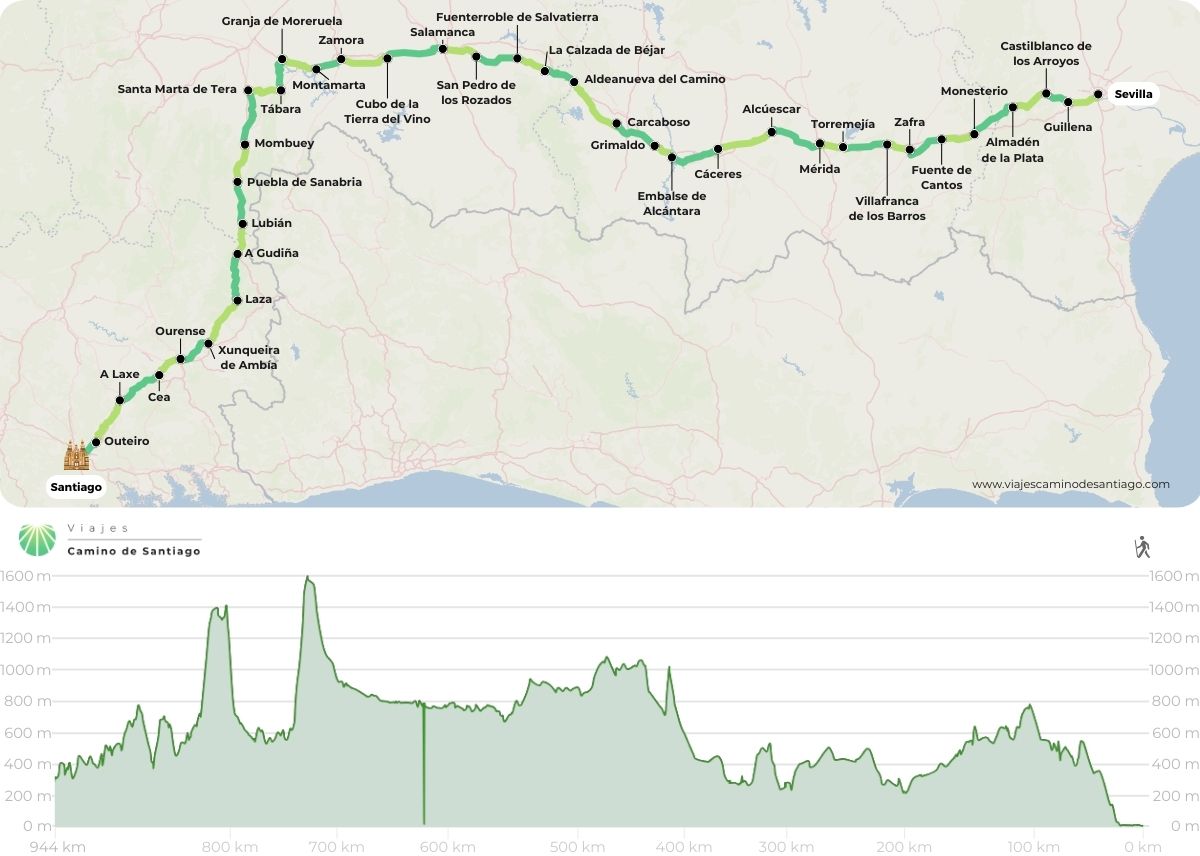
Type of accommodation
In hotels, guesthouses and rural houses in the Via de la Plata
Detalles
Services included
Optional Services
| Servicio | In hotels, guesthouses and rural houses in the Via de la Plata |
|---|---|
| 120€ per person | |
| 295€ per person | |
| 280€ per person | |
| 55€ sing. room / 70€ doub. room | |
| 415€ by bicycle | |
| 485€ by bicycle | |
| 685€ by bicycle |
| Breakfast | ||
|---|---|---|
| In hotels, guesthouses and rural houses in the Via de la Plata | 120€ per person | |
| MP (Breakfast and dinner) | ||
| In hotels, guesthouses and rural houses in the Via de la Plata | 295€ per person | |
| Supplement for single room | ||
| In hotels, guesthouses and rural houses in the Via de la Plata | 280€ per person | |
| Extra night in Santiago de Compostela | ||
| In hotels, guesthouses and rural houses in the Via de la Plata | 55€ sing. room / 70€ doub. room | |
| 27” Mountain Bike Rental | ||
| In hotels, guesthouses and rural houses in the Via de la Plata | 415€ by bicycle | |
| 29” Mountain Bike Rental | ||
| In hotels, guesthouses and rural houses in the Via de la Plata | 485€ by bicycle | |
| Electric bike rental | ||
| In hotels, guesthouses and rural houses in the Via de la Plata | 685€ by bicycle | |
Photos
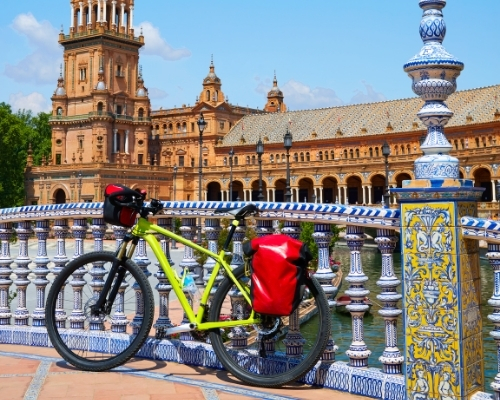
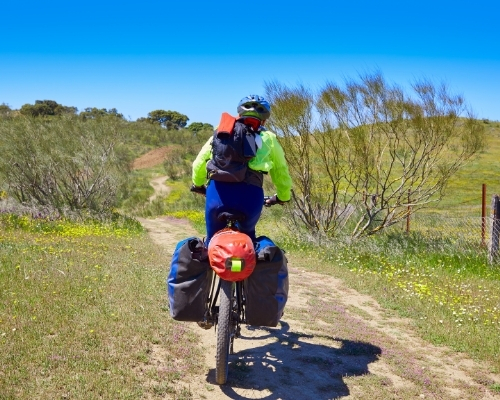
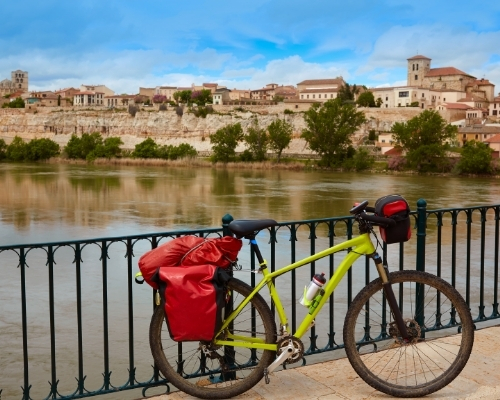
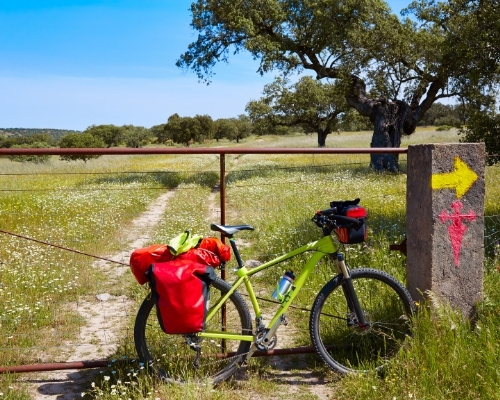
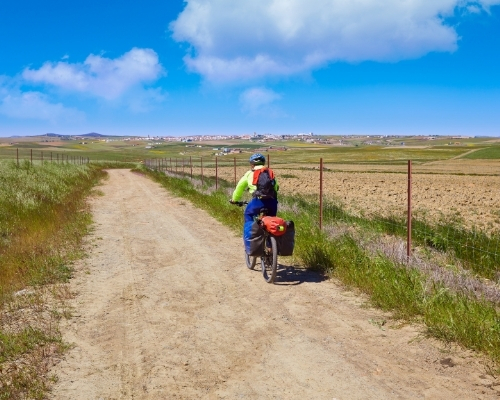
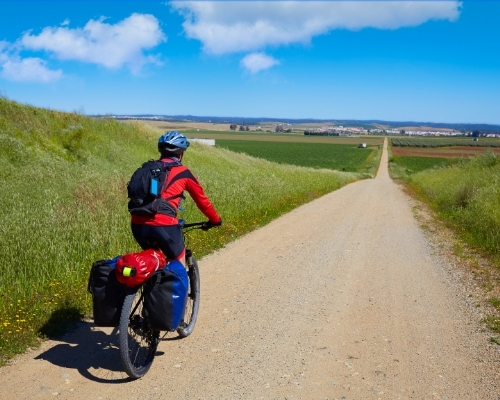
Frequently Asked Questions
The Camino de Santiago by bike includes the following services:
- Accommodation
- Luggage transport
- Dossier with information about the stages
- Pilgrim's credential
- On-the-road helpline
- Travel insurance
In addition, you can customize your trip by adding the following optional services:
- Breakfast or half board
- Extra night at the beginning or end of the stage
- Bicycle rental
Unlike the group trips, no guide or support vehicle is included between stages. However, you will have a 24-hour hotline where you can contact us in case of any problem or unforeseen event, which we will solve quickly.
We have high quality mountain bikes and electric bikes that you can rent during the whole Camino. Check the details here.
In your travel documents, you'll find an emergency telephone number where we're accessible while you're on the road. This ensures you'll journey with peace of mind, knowin our team members will assist you with any problems, incidents, or questions you encounter along your Camino de Santiago.
To make a reservation, you can follow these steps:
- Through our website: Select the route you want and follow the steps indicated in the form. Provide your personal information and that of your companions, choose the type of accommodation, room distribution, meals, transfers, bike rental, etc.
- By email: If you prefer to make the reservation by email or need a personalized trip, you can send us an email to [email protected]. We will provide you with the necessary information to complete the reservation via email.
It is important to note that if the routes or services available on the website do not meet your specific needs, you can request a personalized quote by sending an email to [email protected].

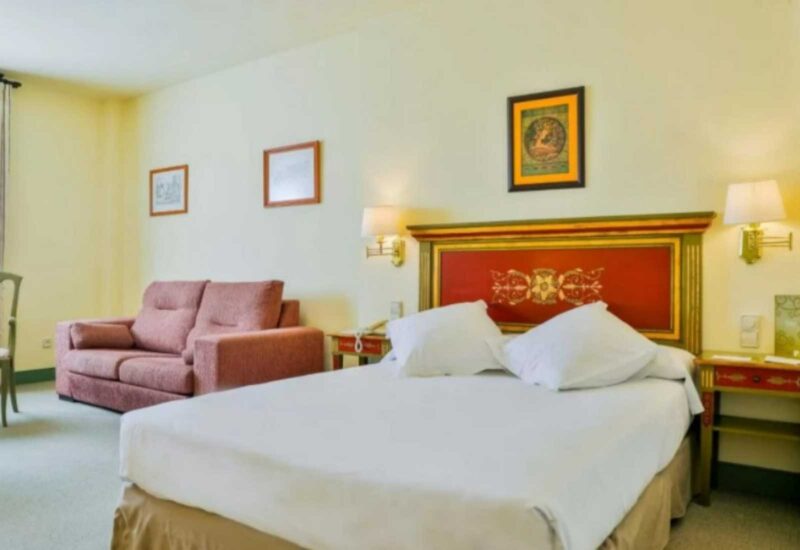
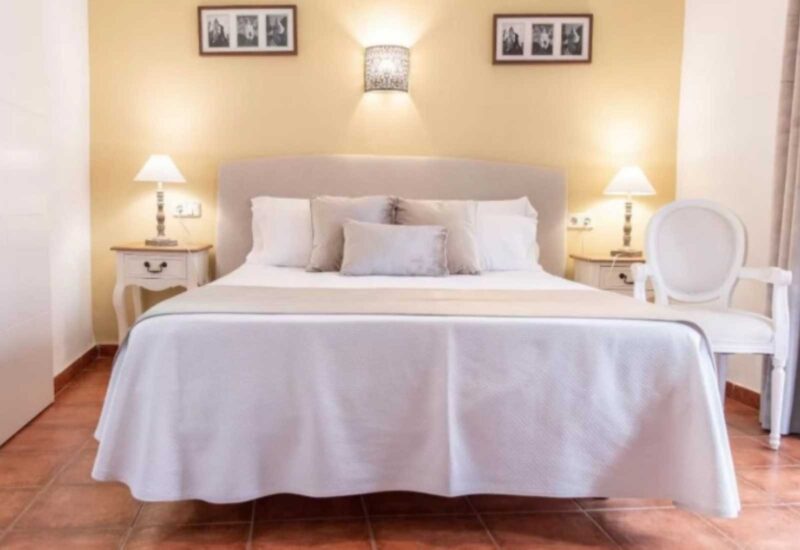
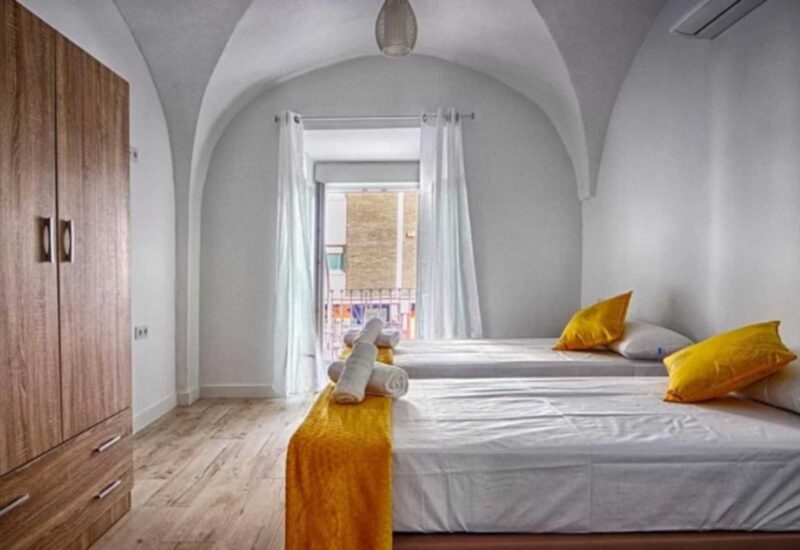
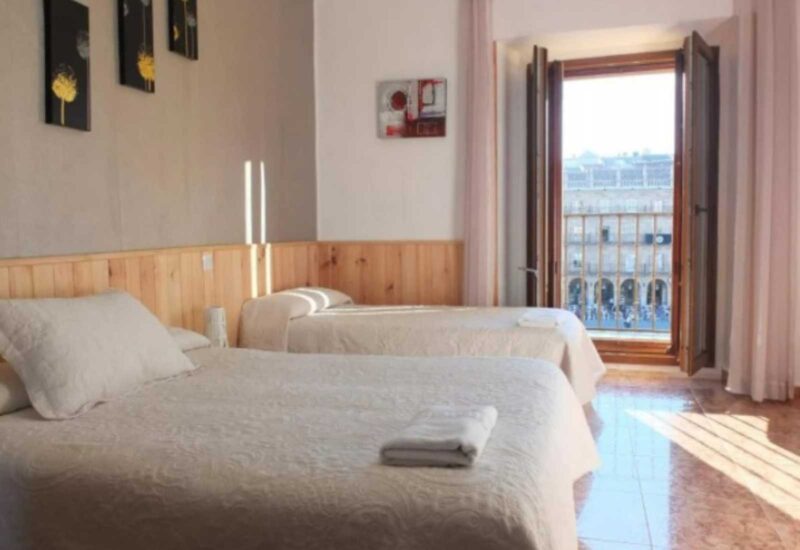
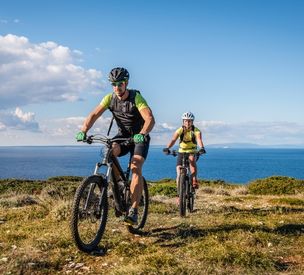
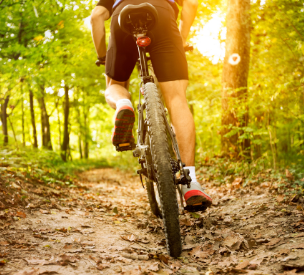
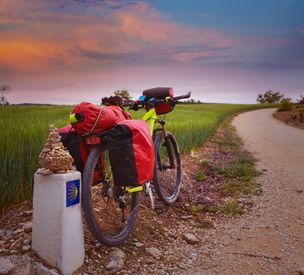
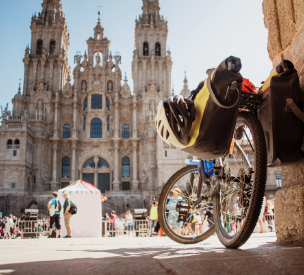

Reviews
There are no reviews yet.